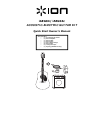
Guitar Features
1. Guitar Audio output: Sends audio from
guitar to the amplifier.
2. Bridge Assembly: Contains Pegs for
holding strings and bridge.
3. Sound Hole: This is where the acoustic
sound exits the guitar.
4. Frets: Raised bars on the neck of the
guitar that designate where the strings
should be pressed to change the sound of
the string.
5. Neck: Surface that the strings are
stretched across to allow for pressing the
strings.
6. Tuning Keys: Rotate these knobs to
tune/adjust the pitch of its corresponding
string.
7. Headstock: Houses the keys for tuning
and winding the strings.
8. Control Module: Houses the on-board
electronic controls.
9. EQ Controls: Adjust the BASS, MID, and
TREBLE output pre-amplifier.
10. Volume Output: Controls the volume
output pre-amplifier.
11. Battery Compartment: Use a 9V
battery to power the on-board electronic
controls.
Step 1: Use the pitch pipe, starting with 6E,
match the pitch with the 6E string. To adjust
the string pitch, simply turn the Corresponding
key on the headstock. (See the Pitch-Pipe
Configuration diagram above)
Follow this same procedure to tune all the
strings on your guitar.
Step 2: After tuning your guitar using the pitch
pipe, you may want to use this optional second
method to fine-tune your guitar, ensuring that
the strings are in tune with each other.
To do this, start by tuning the 5A string to the
6E string by pressing down on the 6E string in
between the 4
th
and 5
th
frets. This will give you
the correct pitch of the 5A string. You can then
rotate the 5A key on the headstock until the
strings sound the same.
From there you can use the same method to
tune the other strings with the exception to
tuning the B2 string. Press down on the 3G
string in between the 3
rd
and 4
th
, instead of the
4
th
and 5
th
frets, to get the correct pitch for the
2B string. (See the Tuning Your Guitar
diagram above)
E
1
B
2
G
3
D
4
A
5
E
6
E1
B2
1st
2nd
3rd
4th
5th
5A4D3G
6E
5A
4D
3G
2B
1E
Pitch-Pipe Configuration
Tuning Your Guitar
3G
2B
1E
4D
5A
6E


















